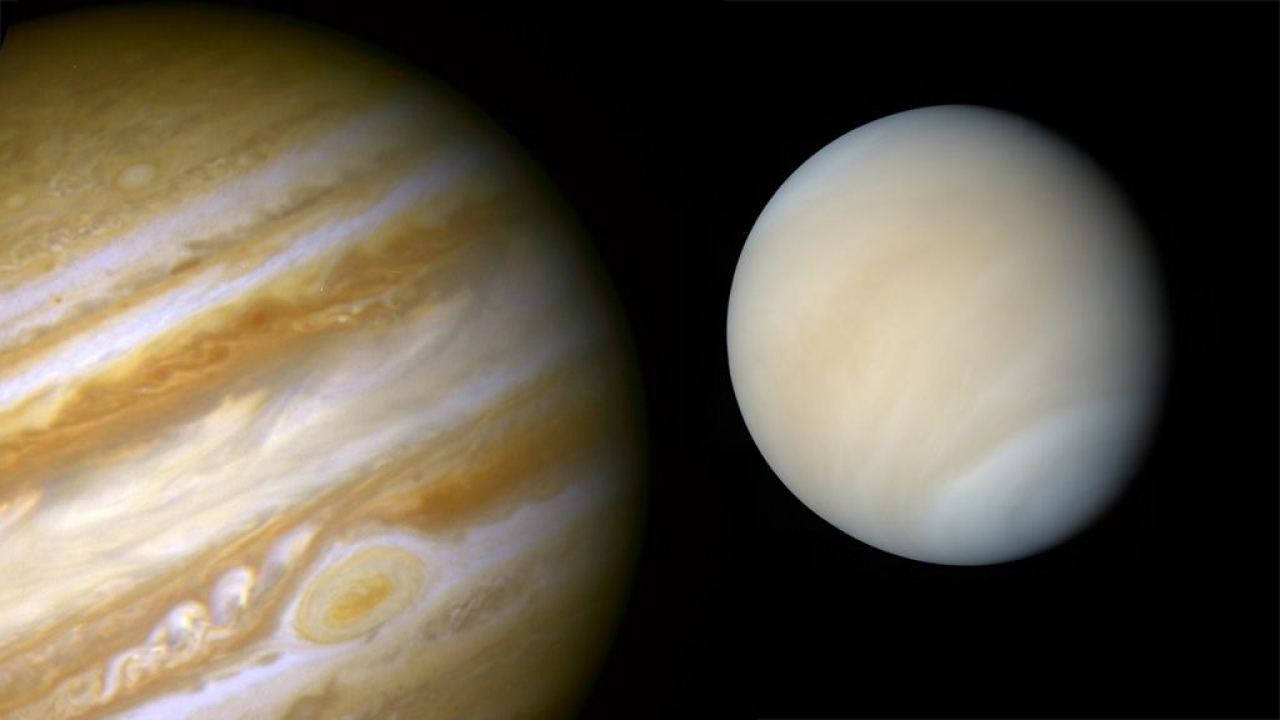Home>Gardening News and Trends>Which Planets Have Greenhouse Effect


Gardening News and Trends
Which Planets Have Greenhouse Effect
Modified: January 22, 2024
Find out the latest news on planets with greenhouse effects and understand the impact of this phenomenon on our solar system.
(Many of the links in this article redirect to a specific reviewed product. Your purchase of these products through affiliate links helps to generate commission for Chicagolandgardening.com, at no extra cost. Learn more)
Table of Contents
Introduction
The greenhouse effect is a crucial phenomenon that plays a significant role in regulating the temperatures of celestial bodies, including planets in our solar system. It is a natural process that helps to maintain a habitable environment on Earth, allowing life to thrive. However, understanding the greenhouse effect and its impact on different planets can provide valuable insights into the conditions and compositions of these celestial bodies.
The greenhouse effect occurs when certain gases in a planet’s atmosphere, such as carbon dioxide (CO2), methane (CH4), and water vapor (H2O), trap heat from the sun. These gases act like the glass walls of a greenhouse, allowing sunlight to enter but hindering the escape of heat back into space. As a result, the trapped heat warms up the planet’s surface and lower atmosphere, creating a stable and suitable environment for life.
To comprehend the greenhouse effect on different planets, it is essential to examine their atmospheres. Each planet has a unique composition and thickness of its atmosphere, which determines the abundance and effectiveness of greenhouse gases. Additionally, the distance from the sun, the presence of clouds, and the reflective properties of the planet’s surface also contribute to the greenhouse effect.
Several factors contribute to intensifying or diminishing the greenhouse effect on a particular planet. For instance, the concentration of greenhouse gases, such as CO2 and CH4, has a direct impact on the strength of the effect. Higher concentrations result in more heat being trapped, leading to higher surface temperatures.
Moreover, the presence of clouds can also influence the greenhouse effect. Clouds can either enhance or reduce the effect depending on their composition and altitude. Low-altitude clouds can help cool the planet by reflecting sunlight back into space, whereas high-altitude clouds can trap heat and contribute to warming.
Understanding the greenhouse effect on different planets provides valuable insights into their potential habitability. Let’s take a closer look at some of the planets in our solar system and their greenhouse effect in the following sections.
What is the greenhouse effect?
The greenhouse effect is a natural process that occurs when certain gases in a planet’s atmosphere trap heat from the sun, leading to the warming of the planet’s surface and lower atmosphere. It is called the “greenhouse” effect because it is similar to how a greenhouse functions, where sunlight enters through glass walls but heat is retained inside.
When sunlight reaches a planet, a portion of it is absorbed by the surface, while the rest is reflected back into space. The absorbed sunlight warms the surface, causing it to emit thermal radiation. Greenhouse gases, such as carbon dioxide (CO2), methane (CH4), and water vapor (H2O), in the atmosphere then absorb some of this thermal radiation.
These greenhouse gases absorb the thermal radiation and re-emit it in all directions, including back towards the planet’s surface. This process effectively increases the amount of heat energy in the lower atmosphere, leading to a warming effect. Without the greenhouse effect, the average temperature on Earth would be much colder, making it inhospitable for life as we know it.
It is important to note that the greenhouse effect itself is not a detrimental phenomenon. On Earth, it is a natural and necessary process that helps to regulate temperatures and create a habitable environment. However, human activities, such as the burning of fossil fuels and deforestation, have significantly increased the concentration of greenhouse gases in the atmosphere, leading to an enhanced greenhouse effect.
Excessive greenhouse gas emissions contribute to global warming, which results in various environmental and climatic changes, such as rising sea levels, more intense heatwaves, and disruptions in ecosystems. Understanding and mitigating the human-induced greenhouse effect is crucial to ensure a sustainable future for our planet.
Next, we will explore the ways in which planetary atmospheres contribute to the greenhouse effect and determine its intensity on different celestial bodies.
Understanding planetary atmospheres
The composition and characteristics of a planet’s atmosphere play a crucial role in determining the greenhouse effect on that celestial body. Each planet in our solar system has a unique atmosphere, which consists of various gases and particles that interact differently with incoming sunlight and the planet’s surface.
The thickness of an atmosphere is an important factor in determining the intensity of the greenhouse effect. Planets with thick atmospheres, such as Venus and Titan, are more likely to experience a strong greenhouse effect due to the increased concentration of greenhouse gases. The presence of dense atmospheres allows for more effective trapping of heat, resulting in higher surface temperatures.
Additionally, the distance between a planet and its star impacts the strength of the greenhouse effect. Planets that are closer to their star, like Venus and Mercury, receive more solar radiation, which intensifies the greenhouse effect and leads to hotter surface temperatures. In contrast, planets further away, like Mars and Pluto, receive less solar radiation, resulting in a weaker greenhouse effect and cooler surface temperatures.
The presence of clouds in a planet’s atmosphere also plays a role in the greenhouse effect. Clouds can both amplify and dampen the effect depending on their composition and altitude. Low-altitude clouds, such as stratus clouds, have a cooling effect as they reflect sunlight back into space and decrease the amount of heat absorbed by the planet’s surface. On the other hand, high-altitude clouds, like cirrus clouds, act as greenhouse blankets by trapping outgoing thermal radiation, contributing to warming.
Furthermore, the reflective properties of a planet’s surface, known as its albedo, influence the greenhouse effect. Planets with high albedo, like Saturn with its reflective icy rings, reflect a significant portion of incoming sunlight, reducing the amount of heat absorbed and thus weakening the greenhouse effect. Conversely, planets with low albedo, such as Earth’s oceans and forests, absorb more sunlight and enhance the greenhouse effect.
Understanding the complexities of planetary atmospheres is crucial in comprehending the variations in the greenhouse effect across our solar system. In the next section, we will take a closer look at some of the planets within our solar system and examine the specific factors that contribute to their greenhouse effects.
Factors contributing to the greenhouse effect
Several factors contribute to the intensity and effectiveness of the greenhouse effect on a particular planet. These factors interact and vary across different celestial bodies, resulting in diverse greenhouse effect strengths. Let’s explore some of the key factors that influence the greenhouse effect on planets.
1. Greenhouse gas concentration: The concentration of greenhouse gases, such as carbon dioxide (CO2), methane (CH4), and water vapor (H2O), in a planet’s atmosphere directly influences the greenhouse effect. Higher concentrations of these gases lead to more effective trapping of heat, resulting in a stronger greenhouse effect and increased surface temperatures. For instance, Venus has an extremely dense atmosphere primarily composed of CO2, resulting in a runaway greenhouse effect and extreme surface temperatures exceeding 800 degrees Fahrenheit (427 degrees Celsius).
2. Atmosphere thickness: The thickness of a planet’s atmosphere plays a vital role in determining the intensity of the greenhouse effect. Planets with thicker atmospheres, like Venus and Titan, have a greater potential for trapping heat due to the higher concentration of greenhouse gases. This leads to higher surface temperatures compared to planets with thinner atmospheres, such as Mars and Pluto.
3. Distance from the sun: The proximity of a planet to its star affects the amount of solar radiation it receives, which directly impacts the greenhouse effect. Planets closer to their star, like Venus and Mercury, receive more solar radiation, intensifying the greenhouse effect and leading to hotter surface temperatures. Conversely, planets further away, like Mars and Neptune, receive less solar radiation, resulting in a weaker greenhouse effect and cooler surface temperatures.
4. Cloud cover: The presence of clouds in a planet’s atmosphere can either enhance or dampen the greenhouse effect. Low-altitude clouds, such as stratus clouds, reflect sunlight back into space, reducing the amount of heat absorbed by the planet’s surface and thereby cooling the planet. In contrast, high-altitude clouds, like cirrus clouds, act as greenhouse blankets by trapping outgoing thermal radiation, leading to warming effects.
5. Surface albedo: The reflective properties of a planet’s surface, known as its albedo, also impact the greenhouse effect. Planets with high albedo, such as those with icy surfaces or extensive cloud cover, reflect a significant portion of incoming sunlight, reducing the amount of heat absorbed and weakening the greenhouse effect. In contrast, planets with low albedo, such as Earth with its dark oceans and forests, absorb more sunlight, enhancing the greenhouse effect.
By considering these factors, scientists can better understand and simulate the greenhouse effect on different celestial bodies. In the following section, we will delve into specific examples of planets within our solar system and analyze their greenhouse effects in more detail.
Planets with the greenhouse effect
The greenhouse effect is not exclusive to Earth; it also occurs on other planets within our solar system. Let’s take a closer look at some of the planets that experience a significant greenhouse effect and the resulting conditions they exhibit.
1. Venus: Venus has the most extreme greenhouse effect in our solar system. Its thick atmosphere, composed primarily of carbon dioxide (CO2), traps an immense amount of heat. This runaway greenhouse effect has caused surface temperatures on Venus to reach scorching levels of around 900 degrees Fahrenheit (475 degrees Celsius), making it the hottest planet in our solar system.
2. Earth: Earth’s greenhouse effect is essential for maintaining our planet’s habitable conditions. The presence of greenhouse gases, such as carbon dioxide, methane, and water vapor, allows for the regulation of temperature. However, human activities, such as the burning of fossil fuels, have intensified the greenhouse effect on Earth, leading to global warming and climate change.
3. Mars: Mars also experiences a greenhouse effect, although it is relatively weaker compared to Venus and Earth. The thin atmosphere on Mars, mainly composed of carbon dioxide, contributes to the trapping of heat but in a significantly lesser extent. Surface temperatures on Mars vary significantly, ranging from freezing temperatures to slightly above zero degrees Fahrenheit.
4. Titan: Saturn’s moon Titan possesses thick clouds and a dense atmosphere mainly composed of nitrogen. The presence of methane in Titan’s atmosphere acts as a greenhouse gas, resulting in a significant greenhouse effect. However, the extremely low temperatures on Titan, averaging around -290 degrees Fahrenheit (-179 degrees Celsius), prevent it from being a habitable environment.
5. Jupiter and Saturn: Gas giants like Jupiter and Saturn also exhibit a greenhouse effect, although the composition and conditions are vastly different from rocky planets. These gas giants have thick atmospheres composed primarily of hydrogen and helium. The presence of trace amounts of methane and ammonia contributes to the greenhouse effect, leading to increasing temperatures as you move deeper into the atmospheres of these massive planets.
Each planet’s specific atmospheric conditions and composition result in varying greenhouse effects, leading to a diverse range of temperatures and environments across the solar system. Understanding these differences provides valuable insights into the complexities of planetary atmospheres and the potential for habitable environments beyond Earth.
Conclusion
The greenhouse effect is a crucial natural process that plays a vital role in regulating the temperatures of planets within our solar system. By understanding the greenhouse effect and its impact on different planets, we gain valuable insights into the conditions and compositions of celestial bodies beyond Earth.
Planetary atmospheres, greenhouse gas concentrations, distance from the sun, cloud cover, and surface albedo all contribute to the greenhouse effect’s intensity on a particular planet. Each planet has a unique combination of these factors, resulting in diverse greenhouse effect strengths and surface temperatures.
Earth serves as an example of a planet with a crucial and balanced greenhouse effect, allowing for habitable conditions. However, human activities have amplified the greenhouse effect on Earth, resulting in global warming and climate change.
Venus demonstrates an extreme greenhouse effect, with its thick atmosphere of carbon dioxide leading to scorching temperatures. Mars experiences a milder greenhouse effect due to its thin atmosphere, while gas giants like Jupiter and Saturn exhibit greenhouse effects within their expansive atmospheres composed mainly of hydrogen and helium.
Understanding the greenhouse effect on different planets provides valuable insights into the potential habitability and conditions of other celestial bodies. By studying the greenhouse effect beyond Earth, scientists gain a broader understanding of the factors that contribute to maintaining a stable and habitable environment.
As we strive to address the challenges posed by global warming on our own planet, the knowledge gained from studying the greenhouse effect on other planets becomes increasingly significant. By mitigating greenhouse gas emissions and working towards sustainable practices, we can help preserve the delicate balance of the greenhouse effect on Earth, ensuring a habitable future for generations to come.







